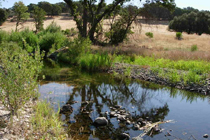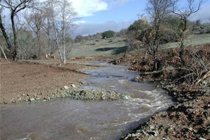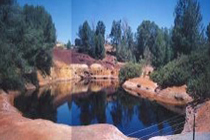Mining Program - Region 5 Success Stories
The Spenceville Mine Reclamation, Nevada County
The Spenceville Mine Reclamation, Nevada County
Spenceville mine is an abandoned mine located in Nevada County. The mine opened in 1860 and mined copper until it closed in 1918. The land is now owned by California Department of Fish and Wildlife and is part of the Spenceville Wildlife Refuge.
Rainwater would pass through the tailings where it picked up much of its pollutants and would then flow into the mine pit. Metals concentrations of the mine pit water increased significantly with depth and had low pH. Copper was 30 ppm at a depth of 3 feet, 160 ppm at a depth of 16 feet, and 230 ppm at a depth of 32 feet. At the same depths, zinc concentrations were 20, 45 and 220 ppm and sulfate concentrations were 1,300, 4,800 and 14,000 ppm. Concentrations of copper and zinc exceeded Title 22 threshold concentration limits for hazardous waste. During winter the mine pit often would overflow into Little Dry Creek. Water from the mine pit would also seep into the creek from underground fissures and other means. Metals concentrations and pH varied in the creek during different seasons due to intermittent flow.
Remediation of the mine site addressed three main site features, including the mine pit water, acid-generating tailings, and Little Dry Creek. Water in the mine pit was pumped to an on-site treatment plant for treatment. The treated water was discharged to land. Sludge created by the water treatment process was sent to an off-site hazardous waste disposal facility. The tailings were treated with a neutralizing agent and then used to fill in the mine pit. After treatment the tailings had a pH of 7.0-7.2. Native soil was used to cover the treated tailings and finish filling the mine pit. Little Dry Creek was relocated 65 feet away from the mine site, which prevented the creek from eroding the reclaimed area. California Fish and Wildlife replanted approximately 100 trees to help stabilize the relocated streambed. Water quality of the creek improved once the source of pollution was removed, as indicated by lower metals concentrations and higher pH.






